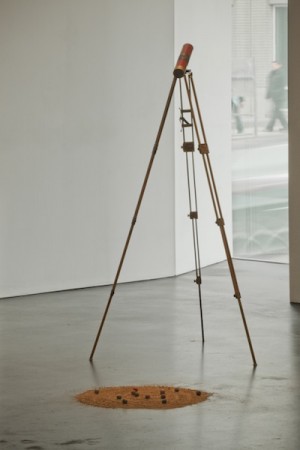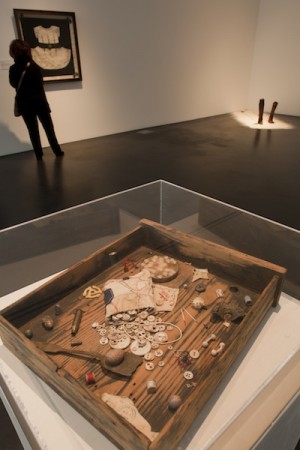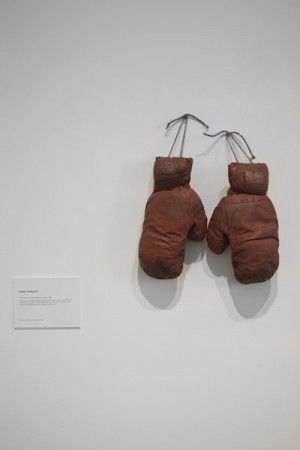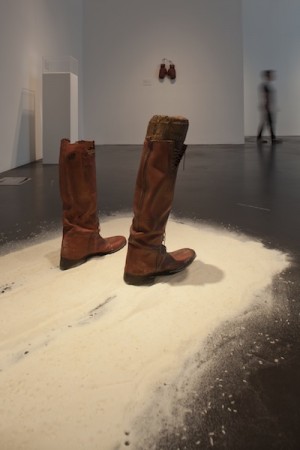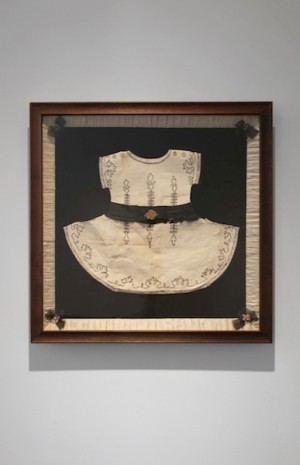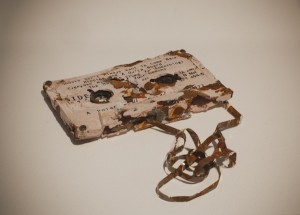
At War With The Entropy Of Nature/Ghosts Don’t Always Want To Come Back, 2002
Dario Robleto: War’s “Life Instinct” in Memento Mori
A garden, while associated with the natural world, is actually a human creation. A place where humans exert control over nature’s chaos. In war, the human need to control what is utterly chaotic and unnatural is amplified. In extreme combat, citizens and soldiers often make what scholar Kenneth I. Helphand calls defiant gardens. These defiant gardens are an adaption to challenging circumstances – a response to a basic need, an aid to survival, but also an assertion and an affirmation of life.
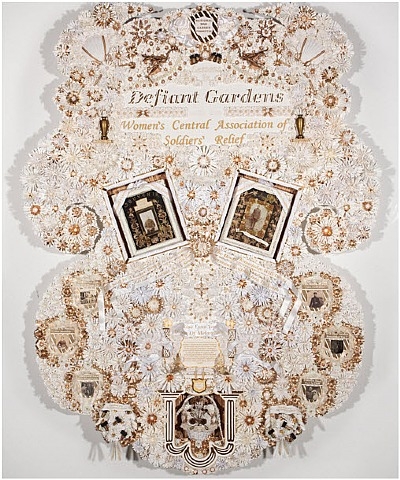
Defiant Gardens
The assertion of humanity amid brutality is the story that Houston artist Dario Robleto attempts to create in his “Defiant Gardens,” a seven foot tall, five foot wide wreath-shaped “memory sculpture” that bursts forth at MCA/Denver in the exhibition, An Instinct Towards Life. A memory sculpture , not precisely a memorial, displaces past into presence. “Defiant Gardens” is a flowering of decorative objects and forms and includes artifacts of war like the skeleton of a carrier pigeon, shrapnel, a message capsule carried by pigeons.
“Three Denver veterans allowed the artist to weave their experiences into his story and anchor this sculpture within our local context,” curator Nora Burnett Abrams writes in a gallery guide. Robleto did this by using their letters and fabric of their uniforms. But because the viewer doesn’t know what war the items originated from, or which battle, or who the soldiers are, the artist creates an anonymous yet potent story about war and its forgotten episodes that knit generations – and all those invisible, prime players whose names we never know.
Robleto begins his process first by writing lists of materials, arranging them into lyrical poems, and titling the lists. He creates these “liner notes” before he ever begins fabricating. Here is the list for “Defiant Gardens”: cut paper, homemade paper: pulp made from soldiers’ letters sent home and wife/sweetheart letters sent to soldiers from various wars, cotton), thread and fabric from soldiers’uniforms of various wars, carrier pigeon skeletons, WWII-era pigeon message capsules, dried flowers from various battlefields, hair flowers braided by war widows, mourning dress fabric, excavated shrapnel and bullet lead from various battlefields, various seeds, various seashells, cartes de visite, gold leaf, silk, ribbon, wood, glass, foam core, glue.
Even though an Instinct Towards Life is built from mementos of war, experiencing the work is not about reading the materials list and then looking at those materials. As Burnett Abrams writes in the catalog:
Instead, the text and the object form a proposition to the viewer such that reading and looking collapse into another enterprise entirely: to imagine and to remember.
The artist does not seek to replicate battle experiences. He never served in the armed forces. What he does is tell stories of how war alters. He avoids making clichés possibly because he is so catholic as he explores the experience of war from multiple perspectives – those of soldiers, families, doctors. The works are delicate, intricate, complex. Each object speaks with its own voice, its own power; no voice overshadows another. The works come together in a melancholic yet hopeful song about the enduring human spirit.

